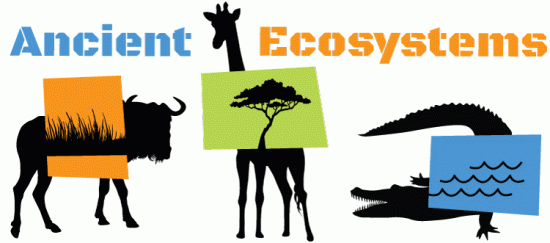
Ancient Ecosystems
show/hide words to know
Habitat: the environment of a species that includes both living and non-living elements.
Paleoecology: the study of the ecological context of fossil species. ... more
 A baboon shuffles along the savanna, picking up seeds and tucking them into its mouth. A herd of gazelles canters past, startled into frantic action by the pounce of a lion. Flies buzz around the eyes and mouth of a zebra drinking at a watering hole, and a bird lands on an acacia tree.
A baboon shuffles along the savanna, picking up seeds and tucking them into its mouth. A herd of gazelles canters past, startled into frantic action by the pounce of a lion. Flies buzz around the eyes and mouth of a zebra drinking at a watering hole, and a bird lands on an acacia tree.
These plants and animals are all interacting together and make up a network of life. A group of animals and plants and the place where they live together is called an ecosystem. The study of ecosystems and the relationships between all living things is called ecology.
What did fossils eat?
It is possible to learn more about the environment where animals live by studying the animals themselves. Here’s an example: Giraffes eat leaves high up on trees. Wildebeests eat grasses close to the ground. So, scientists can tell what kind of plants should grow in a location by knowing what animals were living there. If they find giraffe fossils, they can tell there must have been trees close by because the giraffe needed trees to eat. If they find wildebeest fossils, they know there must have been grasses there.
Scientists study plants and animals of today to understand what life was like millions of years ago. This field of study is called “paleoecology”—“paleo” meaning very old, and “ecology” meaning the study of plants, animals, and environment.

Researchers look at the groups of animals found at fossil sites to learn more about that kind of habitat. Many ancient animals are similar to today’s animals. Like a gazelle on the savanna today, ancient hooved animals similar to gazelles would have eaten leaves and grasses. So their ancient environment would have been similar to today’s African savannah.
Paleoecologists—or scientists who study paleoecology—look at the fossil animals and figure out what kind of environment they lived in. Paleoecologists also study soil, rock, and volcanic ashes to help understand the ancient environment.
Kaye Reed, ancient investigator
ASU researcher Kaye Reed is a paleoecologist. Reed studies fossil mammals, including fossil primates, in South and East Africa.
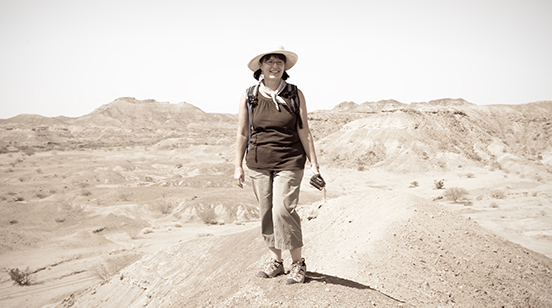
By looking at how animal populations changed over time, Reed can figure out how the environment may have changed. Because the animal fossils can be identified as belonging to a particular period of time, researchers can compare how different animal groups changed over time. Finding crocodile, hippo, and fish fossils would mean it was a wet environment, with more trees nearby. Grass eating gazelles and other hooved animals mean a grassy plain with fewer trees and less water.
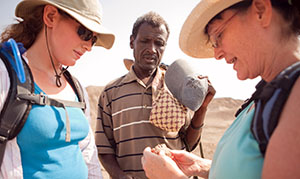 This information can then be applied to how the earliest humans lived and evolved. And paleoecologists can better understand why our earliest human ancestors began changing into the humans we are today.
This information can then be applied to how the earliest humans lived and evolved. And paleoecologists can better understand why our earliest human ancestors began changing into the humans we are today.
Reed’s research takes place in a lab at ASU and in the field. She has been the codirector for the Ledi-Geraru Research Project in Ethiopia since 2002. As codirector, she established the site’s ongoing research goals for a large, international team of scientists. Reed’s leadership with the Ledi-Geraru project makes her one of a few women in paleoanthropology to run her own field site.
Ledi-Geraru
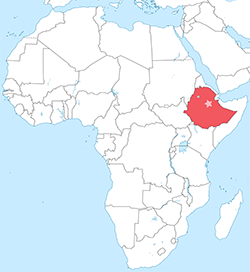 Ledi-Geraru is just a few miles from Hadar, where the famous fossil skeleton “Lucy” was found in 1974. The age of the Lucy fossil is around 3.2 million years old. The age of a fossil is determined from dating the age of volcanic ash close to where the fossil is found.
Ledi-Geraru is just a few miles from Hadar, where the famous fossil skeleton “Lucy” was found in 1974. The age of the Lucy fossil is around 3.2 million years old. The age of a fossil is determined from dating the age of volcanic ash close to where the fossil is found.
The researchers chose to work at Ledi-Geraru because it is near where the Lucy fossil was discovered. Reed’s study of the fossil animals already found there and of the geology show that the fossils are from around the same time period as when Lucy’s species—Australophithecus afarensis—lived. Reed’s review of the community of fossil animals has created an idea what the ecosystem was probably like.
In 2013, the Ledi-Geraru research team made an incredible discovery. An ASU graduate student working with the research team found a piece of a human-like jaw with intact teeth. The age of the fossil is 2.8 million years old. It is the oldest known fossil of the genus Homo, the genus to which modern humans belong. This discovery pushed back the known age of our genus by 400,000 years.
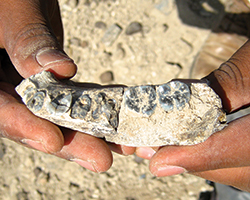 During this time period, other extinct lines of our earliest ancestors were living alongside each other. This includes Lucy’s species and the robust Australopiths. The discovery of the Homo jaw bone is important to understanding human evolution. It shows that our own genus Homo lived at the same time as other human-like species. Ledi-Geraru remains an active and dynamic field site where human evolution continues to be investigated.
During this time period, other extinct lines of our earliest ancestors were living alongside each other. This includes Lucy’s species and the robust Australopiths. The discovery of the Homo jaw bone is important to understanding human evolution. It shows that our own genus Homo lived at the same time as other human-like species. Ledi-Geraru remains an active and dynamic field site where human evolution continues to be investigated.
Reed continues to study fossil animals from places where we find human ancestor fossils. She wants to paint a picture of what the entire mammal community would have looked like at those times and places. Through the animals, we can understand the environment that early humans lived in. Her goal is to explain where human ancestors fit into the bigger picture of the ecosystem throughout our evolution and the reasons their evolution may have happened the way that it did.
After a successful business career, Reed followed her passion to study anthropology.
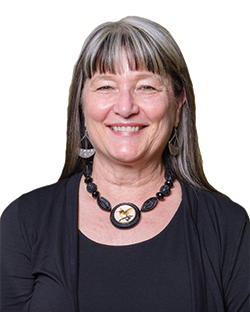 She earned a PhD from State University of New York, Stony Brook, in 1996. Reed joined the Institute of Human Origins (IHO) as a postdoctoral scholar in 1996, in Berkeley, California. In 1997, she moved with IHO to Arizona State University (ASU) and began her career as a professor at ASU.
She earned a PhD from State University of New York, Stony Brook, in 1996. Reed joined the Institute of Human Origins (IHO) as a postdoctoral scholar in 1996, in Berkeley, California. In 1997, she moved with IHO to Arizona State University (ASU) and began her career as a professor at ASU.
Reed is a President’s Professor and Director of the School of Human Evolution and Social Change at ASU. She is also a Research Associate with the Institute of Human Origins.
View Citation
Bibliographic Details
- Article: Ancient Ecosystems
- Author(s): Amy Peterson, Alexandra Norwood
- Publisher: Arizona State University Institute of Human Origins Ask An Anthropologist
- Site name: ASU - Ask An Anthropologist
- Date published: November 2, 2018
- Date modified: May 20, 2019
- Date accessed: September 01, 2024
- Link: https://askananthropologist.asu.edu/profiles/ancient-ecosystems
APA Style
Amy Peterson, Alexandra Norwood. (2018, Nov 02). Ancient Ecosystems. Retrieved September 01, 2024, from https://askananthropologist.asu.edu/profiles/ancient-ecosystems
American Psychological Association, 6th ed., 2nd printing, 2009.
For more info, see the APA citation guide.
Chicago Manual of Style
Amy Peterson, Alexandra Norwood. "Ancient Ecosystems." ASU - Ask An Anthropologist. Published November 2, 2018. Last modified May 20, 2019. https://askananthropologist.asu.edu/profiles/ancient-ecosystems.
Chicago Manual of Style, 17th ed., 2017.
For more info, see the Chicago Manual citation guide.
MLA Style
Amy Peterson, Alexandra Norwood. Ancient Ecosystems. ASU - Ask An Anthropologist. November 2, 2018, askananthropologist.asu.edu/profiles/ancient-ecosystems. Accessed 2024 September 01.
Modern Language Association, 8th ed., 2016.
For more info, see the MLA citation guide.
What can rocks and sediments tell us about how our ancient ancestors developed over the last 4 million years?
Answer »








